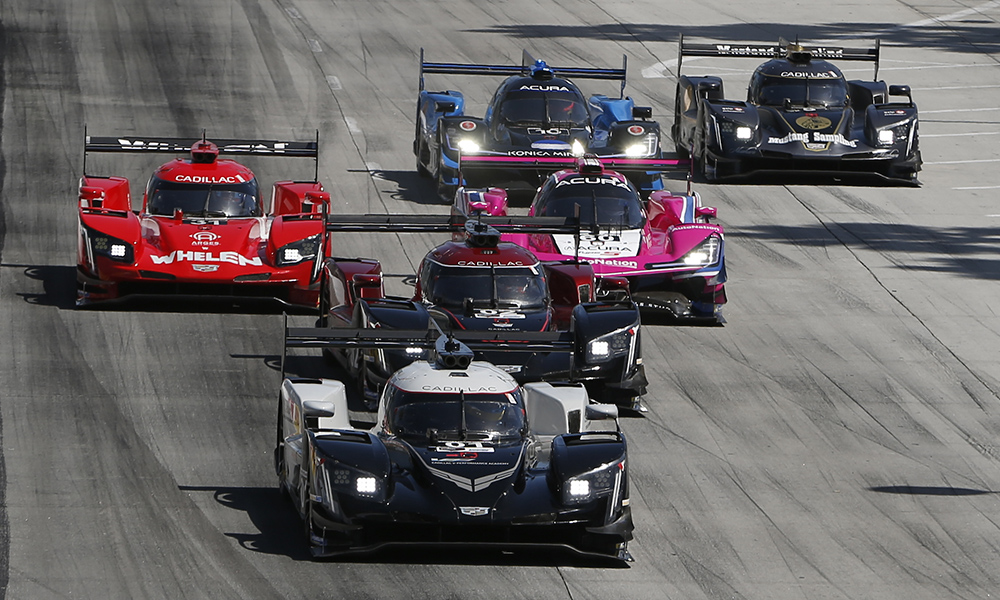
Photo: Jake Galstad/IMSA
The series of minimum weight adjustments in the DPi class have been explained by IMSA, with the sanctioning body’s technical director Matt Kurdock confirming that a form of track-specific Balance of Performance has been utilized per Acura and Cadillac’s requests.
Confirmation of the revised BoP process comes ahead of this weekend’s Sahlen’s Six Hours of The Glen, which sees both the Acura ARX-05 and Cadillac DPi-V.R return to the same base weights of 930 kg and 945 kg, respectively, from last year’s race.
According to Kurdock, the run of five consecutive BoP adjustments since the Mobil 1 Twelve Hours of Sebring was made to ‘proactively’ adjust for the “predictive performance” at specific tracks to help close the performance gap between the two DPi models.
The Dallara-chassied Cadillacs have generally excelled on the street circuits of Long Beach and Detroit, which explains the 10 kg weight break given to the Acura at both races and a 15 kg weight increase for Cadillac in Belle Isle.
By the same token, the Cadillac received a 10 kg weight break for Mid-Ohio, which had been a circuit dominated by Acura.
“We’ve run these cars for quite a long time and we’ve got a decent notebook of where each one of these cars excel and perhaps don’t excel at the different circuits,” Kurdock told Sportscar365.
“In 2021, the ITC (IMSA technical committee) held the DPi BoP fairly constant throughout the season when we had the three manufacturers.
“That produced an interesting notebook, when you’re holding the BoP constant, to be able to see how the car performance is varying from venue to venue.
“Going into 2022, we had some feedback from both Acura and Cadillac that at the beginning of the season and front-loaded couple of races that, ‘we’ve got these circuits that tend to swing one way and swing the other and would IMSA consider track-specific BoP in those cases?’
“You’ve seen through the adjustments that IMSA was looking at historical performance of the cars at these circuits to be proactive about making adjustments to weight to try and compensate for the handling discrepancies between the two platforms at the two street course and Mid-Ohio and Laguna Seca.
“That is essentially, by it’s nature, was adjusting for the predictive performance of those circuits but at the same time trying to maintain what we believed to be the cumulative performance adjustment on the cars with the teams that are currently operating the cars.”
Kurdock said that it’s the hope of the IMSA technical committee that the BoP will be more “stabilized” for the remainder of the year and not necessarily adjusting for each particular track.
“As we go into Watkins Glen, obviously, this was a circuit where the Mazda was quite good at,” he said. “We don’t have the Mazda with us [anymore] and you’ve seen that we’ve returned to essentially the same weights as last year.
“We’re going back to CTMP that’s had some resurfacing, so our notebook is not as good on that circuit.
“But our hope as a committee, now that we’re through where we saw the larger swings in performance one way or another, is that we’re now into a period where we can see more stabilized BoP on those cars for the remainder of the year.
“It will certainly continue to follow our process of going through the data after each event and referencing our historical data and our simulation data to make sure that we’re maintaining as close of a balance for this championship as we can.
“It’s always our intent to have stability in the BoP. We can’t speak to what we’ll do coming out of this race or what we’ll do coming out of CTMP until we actually collect that data.
“But our intent from here on out would be to run around the range of BoP that we’re in right now.”
While the 2021 season saw only saw minor adjustments in the DPi class BoP, Kurdock explained that it was made for a different dynamic due to the existence of a third manufacturer in Mazda.
“If you go back to last year’s data, you’d see that at least with these two platforms, it was a fairly decent balance,” he said. “I think we’ll certainly learn as we go through these events to see if that holds true.
“It’s our duty as a committee to keep the racing as close as we can at every circuit.
“In 2021, the objective was to keep it as close as we could over the course of the championship but what we’ve done this year, we’re trying to keep it closer at those races within the championship as well.
“It’s especially difficult when you have two manufacturers. It becomes more pronounced. With having Mazda in there, it was a very different dynamic.
“If two [manufacturers] were close and one was an outlier, that’s one thing, but with there only being two, one could be an outlier at every race.”

























